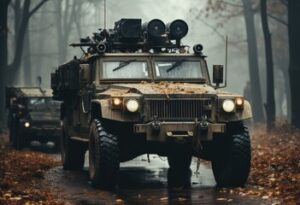Since they made their debut during a major military invasion in 1989 and later in the Gulf War in the 1990s, the Military Humvee has become widely recognized. Originally developed by multiple defense contractors, these vehicles are also known as HMMWVs or Humvees.

In the realm of military vehicles, few have captured the public’s imagination like the Humvee. This large, four-wheel-drive vehicle has served ground forces worldwide and remains one of the most iconic military vehicles in history. Today, Humvees are still in use in various countries and by civilian organizations in a wide range of roles. Over time, the Humvee has undergone several upgrades and modifications to improve its performance and capabilities. Stay tuned for more information on Military Humvee For Sale.
In its original form, the Humvee (officially known as the High Mobility Multipurpose Wheeled Vehicle) was an impressive off-road machine, built to conquer desert terrain with ease. The vehicle was popular with soldiers and quickly made its way into civilian life. For instance, a famous celebrity once owned a Humvee before becoming an advocate for environmental standards.
The concept of the Humvee was first introduced in the late 1970s, when the military sought to replace its aging fleet of Jeeps. In 1979, a request for proposals was issued, and several manufacturers submitted prototypes. Eventually, the military selected a few companies to produce the HMMWV and test them in tough environments.
While the initial Humvees were reliable and durable, they were not designed for modern urban warfare, leaving them vulnerable to small arms fire and improvised explosive devices (IEDs). In response, soldiers in conflict zones began modifying their Humvees, sometimes removing doors and adding makeshift armor.
By 2007, the military started replacing its Humvees with a new generation of mine-resistant vehicles, designed to offer better protection against IEDs, though these new vehicles sacrificed mobility. Some experts believe that the Humvee could see a resurgence as a low-cost, unmanned military vehicle in the future.
The Second Humvee
The Humvee was originally designed to replace the military’s older fleet of jeeps and light trucks. Its primary role is to transport soldiers and cargo in various environments, from deserts to forests and cities. Many other military and civilian organizations also use it for various tasks.
The vehicle’s development began in 1979, and production followed a few years later. Initially, it was intended to replace outdated vehicles in the military. The need for a more durable and maneuverable vehicle was a key factor in its development. The new vehicles needed to carry heavy loads, navigate different terrains, and offer protection to troops from roadside bombs.
Over time, the Humvee was adapted for use as an ambulance, a communications vehicle, and a troop transporter. It also became crucial in transporting supplies and wounded soldiers to hospitals for treatment.
Although vital during the Gulf War, the Humvee is gradually being replaced by a new generation of vehicles known as Joint Light Tactical Vehicles (JLTVs). These newer vehicles can carry more troops, offer better protection against roadside bombs, and are more fuel-efficient. They are also more capable of traversing rough roads.
While the JLTV is seen as the future of military transport, the Humvee could still play a role in modern warfare, especially in scenarios where electronic interference or high-tech attacks are a concern. The simplicity of the Humvee’s design may offer advantages in certain situations.
The Third Humvee
Despite the transition to newer vehicles, the Humvee remains in production, with several upgrades aimed at making it more capable. These include more powerful engines, a stronger chassis, and other improvements that enhance its ability to carry more cargo, weapons, and armor.
The streamlined design of the Humvee allows for easier maintenance. Each of the vehicle’s different configurations shares common components, making it simpler for mechanics to work on them. This also reduces repair costs and simplifies the supply chain.
The Humvee is also highly customizable. For example, a troop carrier version can be adapted to transport more soldiers or mount additional weapons. There are also specialized variants designed for specific missions, such as command and control or medical evacuation.
One of the unique aspects of the Humvee’s design is its transportability. It can be air-dropped using parachutes, lifted by helicopters, or loaded onto large cargo planes. There’s even a version designed with foldable tracks, making it easier to disassemble and ship.
Though the Humvee has undergone numerous changes over the years, it remains one of the most versatile and well-regarded vehicles in the world. Its legacy continues to be celebrated by soldiers and civilians alike.
The Fourth Humvee
The Humvee has taken over the roles once held by jeeps and older military light vehicles, and it even inspired a civilian automotive brand. In its most basic form, the Humvee is a diesel-powered, four-wheel-drive vehicle that typically seats three to six passengers. It’s designed for off-road driving and can be equipped with a variety of weapon systems.
The military first began considering the Humvee in 1979, issuing specifications for a new vehicle capable of handling harsh terrains like rocky hills, deep sand, and snow. The vehicle had to meet strict requirements for climbing inclines, traversing slopes, and crossing water without needing a snorkel.
After extensive testing in challenging conditions, the Humvee proved to be highly reliable and durable. Its rugged performance earned it high marks from military evaluators, and soon the vehicles were being used in a wide variety of roles.
Today, the Humvee continues to serve with militaries around the world, often modified to suit local needs. Collectors also prize unmodified versions of the vehicle for their authenticity.
While the military’s next-generation vehicle is expected to take over many of the Humvee’s roles, the Humvee will remain in service as a backup in case the newer models don’t meet expectations. Ongoing improvements to the Humvee focus on extending its reliability and performance.